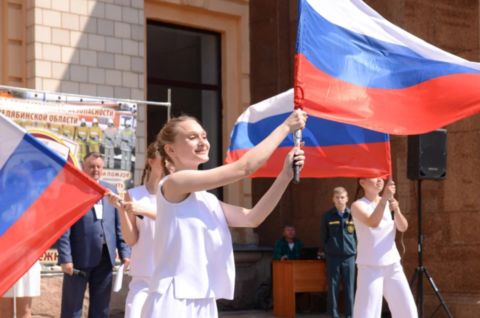Every year our country celebrates the National Flag Day on August 22nd. Though the holiday itself has appeared relatively recently, the flag’s history dates back to a distant past.
One of the first mentions of this flag is the chronicle of the 12th century "The Tale of Bygone Years", which says that Prince Vladimir Monomakh brought with him a golden silk flag from Byzantium, which became a symbol of Christianity and statehood.
The way it looks now the banner was designed in 1705: Emperor Peter the Great signed a decree that made it obligatory for merchant ships to put out the white-blue-red tricolor. On shore it was first used in 1806. Later, during the reign on Alexander II, in 1858 a new imperial state flag was approved, which consisted of black, yellow and white stripes. As a result, two flags were in use: on holidays the black-yellow-white one was put out in government buildings, and the white-blue-red one in private houses. However, on April 28, 1883 a dictation by Alexander III stated that only the white-blue-red banner would be used as the national flag.
It was during the Russian Empire that the design that we see on the modern state flag of our country was approved. Back then the flag consisted of three horizontal stripes: white, blue and red. It became a symbol of Russian statehood and was used until the October Revolution.
After the Soviet power was established in 1917, the flag of our country was changed. The symbols of communism appeared on it: a sickle and a hammer on a red cloth. This flag design was used in the USSR until its collapse in 1991.
Russia officially adopted a new state flag after the collapse of the USSR. This design was chosen as a result of a competition that took place in 1993. The flag of the Russian Federation consists of three horizontal stripes: the top is white, the middle is blue, and the bottom is red. This banner of our country is as a symbol of unity and peace. It also refers to the historical roots of Russia.
As for the holiday celebrating the National Flag Day, it appeared after the August Coup (August 18th to 21st, 1991), which marked the collapse of the USSR. On August 22nd, the Supreme Soviet of the Russian Soviet Federative Socialist Republic issued a decree according to which the tricolour (a cloth of equal horizontal white, sky-blue and scarlet stripes) became our country's national flag.
On the occasion of the restoration of the historical flag in 1994, the first President of Russia Boris Yeltsin announced August 22nd to be public holiday. In his decree, Boris Yeltsin noted that a significant date was necessary "in order to educate the current and future generations of Russian citizens with respect for state symbols".
If we speak about the meaning of the colours in our national flag, then during the time of Peter the Great, white colour symbolized freedom, blue − the Mother of God, red − the strength of the Russian state. There is no official interpretation of the meaning of the colours on the Russian flag, but there are several versions. The most common version is the following:
-
White colour symbolizes purity, independence and peace, and is also a reference to the old Russian coat of arms;
-
Blue colour represents faith, devotion and justice, and also reminds of the blue colour of the mantle of the Mother of God, who is considered a symbol of Russia;
-
Red colour symbolizes courage, strength and bravery, and also reminds of the blood shed for the Motherland.
The national flag of Russia symbolizes the unity, strength and peace of our country. It unites all citizens of Russia, regardless of their nationality, religion or political beliefs. The flag of Russia reminds us of our rich history, the exploits of our ancestors and the significant achievements of our country.
When we raise the flag of Russia on important dates and holidays, we express our love and devotion to the Motherland. This symbol of unity should always remind us of our common goal − the prosperity and well-being of the Russian Federation.




